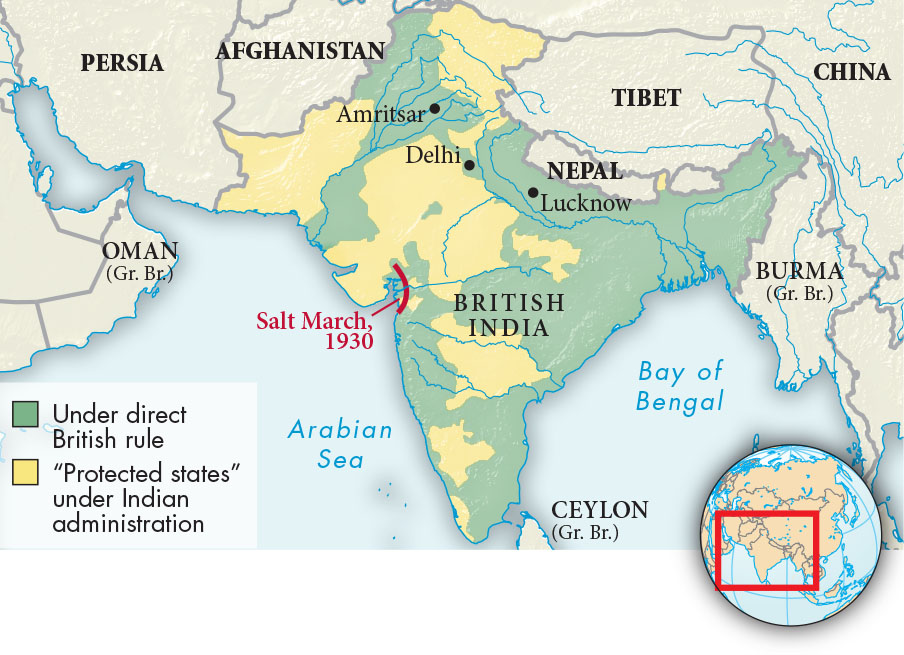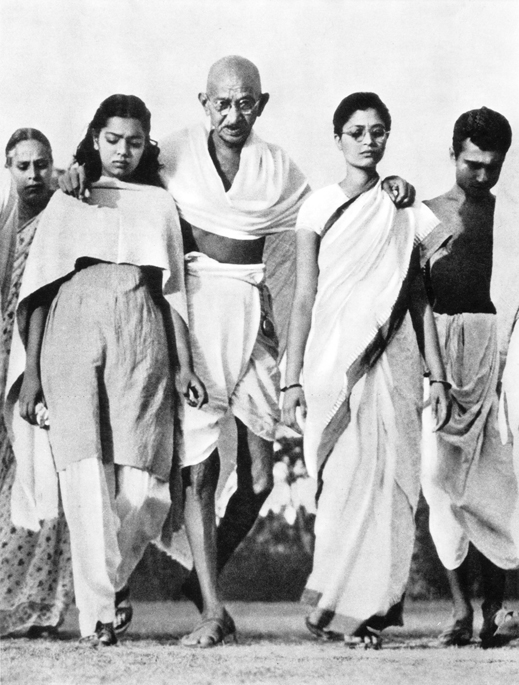A History of World Societies:
Printed Page 899
A History of World Societies Value
Edition: Printed Page 911
Chapter Chronology
Gandhi’s Resistance Campaign in India
In 1915 Gandhi returned to India. His reputation had preceded him: the masses hailed him as a mahatma, or “great soul” — a Hindu title of veneration for a man of great knowledge and humanity. Drawing on his South African experience because he knew Indians could not compete militarily against the British, Gandhi in 1920 launched a national campaign of nonviolent resistance to British rule. Denouncing British injustice and even violence (such as the Amritsar Massacre the year before), he urged his countrymen to boycott British goods, jobs, and honors (such as honorary titles like baron, rai, diwān, and khan, and other awards). He told peasants not to pay taxes or buy English goods, primarily cloth, or the heavily taxed liquor. Gandhi electrified the Indian people, initiating a revolution in Indian politics.
The nationalist movement had previously touched only the tiny, prosperous, Western-educated elite. Now both the illiterate masses of village India and the educated classes heard Gandhi’s call for militant nonviolent resistance. It particularly appealed to the masses of Hindus who were not members of the warrior caste or the so-called military races and who were traditionally passive and nonviolent. The British had regarded ordinary Hindus as cowards. Gandhi told them that they could be courageous and even morally superior:

India, ca. 1930

Gandhi on the Salt March, June 1930 A small, frail man, Gandhi possessed enormous courage and determination. His campaign of nonviolent resistance to British rule inspired the Indian masses and mobilized a nation. Here he is shown walking on his famous march to the sea to protest the English-Indian government’s monopoly on salt production. (akg-images)
What do you think? Wherein is courage required — in blowing others to pieces from behind a cannon, or with a smiling face to approach a cannon and be blown to pieces? Who is the true warrior — he who keeps death always as a bosom-friend, or he who controls the death of others? Believe me that a man devoid of courage and manhood can never be a passive resister.5
Gandhi made the Indian National Congress into a mass political party, welcoming members from every ethnic group and cooperating closely with the Muslim minority.
In 1922 some Indian resisters turned to violence, murdering twenty-two policemen. Savage riots broke out, and Gandhi abruptly called off his campaign, observing that he had “committed a Himalayan blunder in placing civil disobedience before those who had never learnt the art of civil disobedience.”6 Arrested for fomenting rebellion, Gandhi served two years in prison. Upon his release Gandhi set up a commune, established a national newspaper, and set out to reform Indian society and improve the lot of the poor. He welcomed the outcaste untouchables (a caste composed of people who worked in occupations deemed unclean or “polluting”), worked to help child widows who were denied the right to remarry and suffered discrimination, and promoted native cottage industry production. For Gandhi moral improvement, social progress, and the national movement went hand in hand. Above all, Gandhi nurtured national identity and self-respect. He also tried to instill in India’s people the courage to overcome their fear of their colonial rulers and to fight these rulers with nonviolence. (See “Viewpoints 29.1: Gandhi and Mao on Revolutionary Means.”)
The 1920–1922 resistance campaign left the British severely shaken, but the commission formed in 1927 to consider further steps toward self-rule included no Indian members. In the meantime, Gandhi had served two years (1922–1924) of a six-year sentence for sedition, and in his absence the Indian National Congress had splintered into various factions. Indian resentment of British rule was intense and growing throughout the 1920s, and Gandhi spent the years after his release from prison quietly trying to unite the different factions. In 1929 the radical nationalists, led by the able and aristocratic Jawaharlal Nehru (1889–1964), pushed through the National Congress a resolution calling for virtual independence within a year. The British stiffened in their resolve against Indian independence, and Indian radicals talked of a bloody showdown.
Into this tense situation Gandhi masterfully reasserted his leadership, taking a hard line toward the British but insisting on nonviolent methods. He organized a massive resistance campaign against the tax on salt, which gave the British a veritable monopoly on the salt that was absolutely necessary for survival in India’s heat and humidity. As Gandhi shrewdly saw, the tax affected every Indian family. From March 12 to April 6, 1930, Gandhi led fifty thousand people in a spectacular march to the sea, where he made salt in defiance of the law. A later demonstration at the British-run Dharasana salt works resulted in many of the 2,500 nonviolent marchers being beaten senseless by policemen in a brutal and well-publicized encounter. Over the next months the British arrested Gandhi and sixty thousand other protesters for making and distributing salt. But the protests continued, and in 1931 the frustrated and unnerved British released Gandhi from jail and sat down to negotiate with him, as an equal, over Indian self-rule. Negotiations resulted in a new constitution, the Government of India Act, in 1935, which greatly strengthened India’s parliamentary representative institutions and gave Indians some voice in the administration of British India. Although there was little Indian involvement in the drafting of the act, and it was never fully implemented, it served as a blueprint for the constitutions of India and Pakistan when they gained independence soon after World War II.
Despite his best efforts, Gandhi failed to heal a widening split between Hindus and Muslims. Indian nationalism, based largely on Hindu symbols and customs, increasingly disturbed the Muslim minority. Tempers mounted, and both sides committed atrocities. By the late 1930s Muslim League leaders were calling for the creation of a Muslim nation in British India, a “Pakistan,” or “land of the pure.” As in Palestine, the rise of conflicting nationalisms in India based on religion would lead to tragedy (see “Independence in India, Pakistan, and Bangladesh” in Chapter 31).

